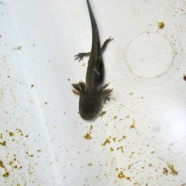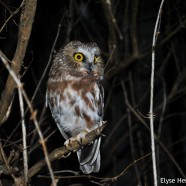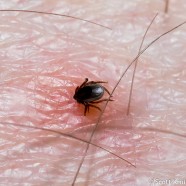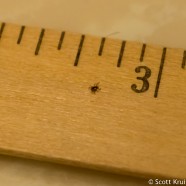Dragons of the Northeastern Forest?
Do you still consider yourself to be a kid at heart? I definitely have my own “kid” moments when I’m out in the field flipping logs or dip netting pools to see what may be living beneath the surface of the forest floor or a body of water. One species in particular that I love to find in our northeastern forests is the spotted salamander (Ambystoma maculatum). Known for their large black bodies spotted with bright yellow dots, this charismatic species is hard to miss when out in the open. However, they are typically only seen out and about once a year; during their spring...
Read MoreNorthern Saw-whet Owl (Aegolius acadicus)
Can anyone say cute?! If you’re a mouse or small songbird, you likely wouldn’t be saying that within ear shot of this owl! The Northern Saw-whet Owl (Aegolius acadicus) is a pint sized predator that is actually quite ferocious when it comes to hunting. Thanks to their nocturnal nature and silent strike, prey don’t even hear them coming. Interestingly, once these owls catch a meal, they often don’t eat it all at once. Saw-whets will eat part of their meal and then save some for leftovers… Yummy right? As autumn continues keep an ear out for these little owls, you...
Read MoreLyme Disease
I have Lyme disease. Thankfully most people have now heard of Lyme disease, but for those who have not, Lyme borreliosis is an infectious disease caused by bacteria of the Borrelia type and transmitted to humans (or pets!) by a black-legged/deer tick bite and subsequent feeding by the parasite. It typically takes 24 or maybe 36-48 hours of feeding for the disease to be transmitted if the tick is a carrier, though this is not a guarantee either direction. Lyme disease can cause flu-like symptoms nearly immediately, and if untreated they can be followed by severe headaches, joint and muscle...
Read MoreDeer Tick
Whether it is a warm and sunny day or a cool, cloudy one you can now expect to find some ticks outdoors, especially in edge habitats. The photo shows a tick I recently pulled off of my dog on an inch ruler. In western New York this is rarely a problem, and only a handful of sites have any ticks to be found. However, in places like Connecticut the population is robust, booming, and filled with diseases. Any time that you or your dog goes outdoors this spring, and throughout the year really, you should be mindful of ticks. The best way to protect yourself is to stay covered, change your...
Read MoreBouncing Babies
Here we have some bouncing baby…umm, boys and girls I would guess. These spotted salamander (Ambystoma maculatum) babies will soon be hatching from their globular masses and become veracious predators in the little vernal pools in which they temporarily reside. As they feed and grow, they will be racing against the clock in order to develop from free swimming legless tadpoles into four legged land dwellers before their nursery pool dries out towards the end of the summer. Talk about rapid development! Elyse Henshaw Conservation Technician
Read More








